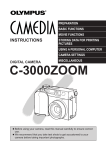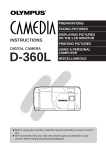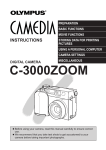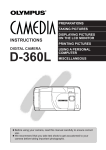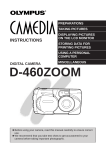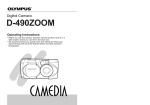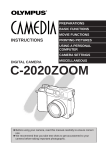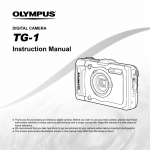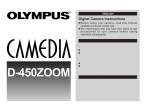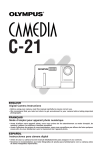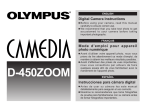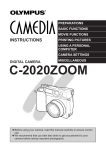Download Olympus CAMEDIA C-2020 User's Manual
Transcript
PREPARATIONS BASIC FUNCTIONS MOVIE FUNCTIONS INSTRUCTIONS PRINTING PICTURES USING A PERSONAL COMPUTER CAMERA SETTINGS DIGITAL CAMERA MISCELLANEOUS C-2020ZOOM n Before using your camera, read this manual carefully to ensure correct use. n We recommend that you take test shots to get accustomed to your camera before taking important photographs. IMPORTANT SAFETY INSTRUCTlONS Thank you for purchasing the Olympus digital camera. Before you start to use your new camera, please read these instructions carefully to obtain optimum performance and a longer service life from the unit. Be sure to retain this manual for future reference. CAUTION RISK OF ELECTRIC SHOCK DO NOT OPEN CAUTION: TO REDUCE THE RISK OF ELECTRIC SHOCK, DO NOT REMOVE COVER (OR BACK). NO USER-SERVICEABLE PARTS INSIDE. REFER SERVICING TO QUALIFIED OLYMPUS SERVICE PERSONNEL. The lightning flash with the arrowhead symbol, within an equilateral triangle, is intended to alert the user to the presence of uninsulated “dangerous voltage” within the product's enclosure that may be of sufficient magnitude to constitute a risk of electric shock to persons. The exclamation point within an equilateral triangle is intended to alert the user to the presence of important operating and maintenance (servicing) instructions in the literature accompanying the product. WARNING: TO REDUCE THE RISK OF FIRE OR SHOCK HAZARD, DO NOT EXPOSE THIS EQUIPMENT TO RAIN, ANY LIQUID OR MOISTURE. 1. Read Instructions — All the safety and operating instructions should be read before the product is operated. 2. Retain Instructions — The safety and operating instructions should be retained for future reference. 3. Heed Warnings — All warnings on the product and in the operating instructions should be adhered to. 4. Follow Instructions — All operating and use instructions should be followed. 5. Cleaning — Unplug this product from the wall outlet before cleaning. Do not use liquid cleaners or aerosol cleaners. Use a damp cloth for cleaning. 6. Attachments — Attachments not recommended by the product manufacturer may be hazardous and/or cause damage to the product. Do not use these attachments. 2 7. Water and Moisture — Do not use this product near water — for example, near a bath tub, kitchen sink, or laundry tub, in a wet basement, near a swimming pool or rain. 8. Accessories — Do not place this product on an unstable stand, tripod, bracket, table, or cart. The product may fall, causing serious injury to a child or adult, and serious damage to the product. Use only with a tripod, stand, or bracket. Any mounting of the product should follow the manufacturer’s instructions, and should use a mounting accessory recommended by the manufacturer. 9. Power Sources — This product should be operated only from the type of power source indicated on the label. If you are not sure of the type of power supply to your home, consult your product dealer or local power company. For products intended to operate from battery power, or other sources, refer to the operating instructions. 10 Grounding or Polarization — This product,when used with an optional AC adapter, may be equipped with a polarized alternating-current line plug (a plug having one blade wider than the other). This plug will fit into the power outlet only one way. This is a safety feature. If you are unable to insert the plug fully into the outlet, try reversing the plug. If the plug should still fail to fit, contact your electrician to replace your obsolete outlet. 11. Power-Cord Protection — Power-supply cords should be routed so that they are not likely to be walked on or pinched by items placed upon or against them, paying particular attention to cords at plugs, convenience receptacles, and the point where they exit from the product. 12. Lightning — For added protection for this product when used with an optional AC adapter during a lightning storm, or when it is left unattended and unused for long periods of time, unplug it from the wall outlet and disconnect the antenna or cable system. This will prevent damage to the product due to lightning and power-line surges. 13. Overloading — Do not overload wall outlets, extension cords, or integral convenience receptacles as this can result in a risk of fire or electric shock. 14. Object and Liquid Entry — Never push objects of any kind into this product through openings as they may touch dangerous voltage points or short-out parts that could result in a fire or electric shock. Never spill liquid of any kind on the product. 15. Servicing — Do not attempt to service this product yourself as opening or removing covers may expose you to dangerous voltage or other hazards. Refer all servicing to qualified service personnel. 3 16. Damage Requiring Service — If using the optional AC adapter, unplug this product from the wall outlet and refer servicing to qualified service personnel under the following conditions: a) If liquid has been spilled, or objects have fallen into the product. b) If the product has been exposed to rain or water. c) If the product does not operate normally by following the operating instructions. Adjust only those controls that are covered by the operating instructions as an improper adjustment of other controls may result in damage and will often require extensive work by a qualified technician to restore the product to its normal operation. d) If the product has been dropped or damaged in any way. e) When the product exhibits a distinct change in performance — this indicates a need for service. 17. Replacement Parts — When replacement parts are required, be sure the service technician has used replacement parts specified by the manufacturer or which have the same characteristics as the original part. Unauthorized substitutions may result in fire, electric shock, or other hazards. 18. Safety Check — Upon completion of any service or repairs to this product, ask the service technician to perform safety checks to determine that the product is in proper operating condition. 19. Heat — The product should be situated away from heat sources such as radiators, heat registers, stoves, or other products (including amplifiers) that produce heat. Radio and Television Interference Change or modifications not expressly approved by the manufacturer may void the user’s authority to operate this equipment. This equipment has been tested and found to comply with the limits for Class B digital device, pursuant to Part 15 of the FCC Rules.These limits are designed to provide reasonable protection against harmful interference in a residential installation.This equipment generates, uses, and can radiate radio frequency energy and, if not installed and used in accordance with the instructions, may cause harmful interference to radio communications. However, there is no guarantee that interference will not occur in a particular installation. If this equipment does cause harmful interference to radio or television reception, which can be determined by turning the equipment off and on, the user is encouraged to try to correct the interference by one or more of the following measures: 4 • Reorient or relocate the receiving antenna. • Increase the distance between the camera and receiver. • Connect the equipment to an outlet on a circuit different from that to which the receiver is connected. Only the included RS-232C serial cable should be used to connect the camera to a personal computer (PC). Declaration of Conformity Model Number: C-2020ZOOM Trade Name: OLYMPUS Responsible party: Olympus America Inc. Address: 2 Corporate Center Drive, Melville, New York 11747-3157 U.S.A. Telephone number: 516-844-5000 This device complies with Part 15 of the FCC rules. Operation is subject to the following two conditions: (1) This device may not cause harmful interference, and (2) This device must accept any interference received, including interference that may cause undesired operation. This Class B digital apparatus meets all requirements of the Canadian Interference-Causing Equipment Regulations. WARNING • Keep the batteries away from children. • If a battery is swallowed, see a doctor immediately. • Dispose of used lithium batteries promptly, in a safe manner that complies with all applicable laws. • The lithium battery may present the risk of fire or chemical burn if mishandled. • Do not recharge, disassemble, heat above 212°F (100°C) or dispose of in a fire. • Before use, wipe the battery clean with a dry soft cloth to assure good contact. • Never use metallic tweezers to hold the battery, and never short circuit the (+) and (–) sides of the battery. Windows® is a registered trademark of Microsoft Corporation. Macintosh™ is a trademark of Apple Computer Inc. All other brand names and product names are registered. 5 Legal and other notices • All contents of this publication are subject to change without notice. • Although the contents of this publication have been carefully checked to avoid errors, some may still occur. If you are in doubt about any points or find mistakes or omissions, please contact us. • No part of this publication may be reproduced or reprinted except for personal use without the prior permission of Olympus. • Olympus makes no representations or warranties regarding any damages, or benefit expected by using this unit lawfully, or any request from a third person, which are caused by the inappropriate use of this unit. • Olympus makes no representations or warranties regarding any damages or any benefit expected by using this unit lawfully which are caused by erasing the picture data. • Olympus reserves all rights to this manual. FOR SAFE USE Warning: Ignoring this Warning mark and operating this product incorrectly may lead to serious injury or death. Caution: Ignoring this Caution mark and operating this product incorrectly may lead to injury. WARNING 1. NEVER TRY TO USE THE FLASH WHEN TAKING PICTURES OF PEOPLE (ESPECIALLY INFANTS) AT CLOSE RANGE. THE CAMERA’S FLASH MAY DAMAGE THE SUBJECT’S EYES AT CLOSE RANGE. DO NOT TAKE PICTURES OF CHILDREN FROM A DISTANCE OF LESS THAN THREE FEET. 2. DO NOT AIM YOUR CAMERA DIRECTLY AT THE SUN OR OTHER EXTREMELY BRIGHT OBJECTS. THIS MAY DAMAGE YOUR EYES. 3. DO NOT USE THIS CAMERA IN THE VICINITY OF FLAMMABLE OR EXPLOSIVE GAS. 6 4. DO NOT LEAVE THIS CAMERA WITHIN THE REACH OF INFANTS OR CHILDREN. • THE CHILD MIGHT PUT THE STRAP AROUND HIS OR HER NECK. THIS COULD CAUSE STRANGULATION OR CHOKING. • THE CHILD MIGHT SWALLOW BATTERIES OR SMALL ATTACHMENTS. IF THIS HAPPENS, CONTACT A PHYSICIAN IMMEDIATELY. • THE CHILD MIGHT ACTIVATE THE FLASH FROM TOO CLOSE AND CAUSE DAMAGE TO HIS OR HER EYES. • THE CHILD MIGHT DAMAGE THE CAMERA. 5. BATTERY FLUID MAY LEAK, GENERATING HEAT AND POSSIBLY CAUSING A FIRE OR EXPLOSION. • DO NOT USE NON-RECOMMENDED BATTERIES. • DO NOT THROW BATTERIES INTO A FIRE, OR EXPOSE TO HEAT. • DO NOT DISASSEMBLE THE UNIT WITH BATTERIES INSIDE. • DO NOT USE NEW BATTERIES AND OLD BATTERIES TOGETHER. DO NOT MIX DIFFERENT TYPES OF BATTERIES OR DIFFERENT MANUFACTURERS’ BATTERIES. • DO NOT CHARGE ALKALINE AND LITHIUM BATTERIES. • KEEP UNLOADED BATTERIES OUT OF THE REACH OF INFANTS AND CHILDREN. IF AN INFANT OR CHILD SWALLOWS THE BATTERIES, CONTACT A PHYSICIAN IMMEDIATELY. • DO NOT LOAD THE BATTERIES IN THE OPPOSITE DIRECTION TO THAT SHOWN IN THESE INSTRUCTIONS. • NEVER USE ANY BATTERY WHOSE BODY IS NOT COVERED BY THE INSULATING SHEET. 6. DO NOT STORE THE CAMERA IN HUMID OR DUSTY PLACES. THIS MAY CAUSE FIRE OR ELECTRIC SHOCK. 7. DO NOT COVER THE FLASH WITH YOUR HAND DURING OPERATION. DO NOT TOUCH THE FLASH AFTER FIRING IT CONTINUOUSLY. YOU MAY GET BURNED. 8. IF YOU DROP THE CAMERA IN WATER OR GET WATER INSIDE IT, UNLOAD THE BATTERIES IMMEDIATELY AND CONTACT YOUR NEAREST OLYMPUS SERVICE CENTER. LEAVING BATTERIES IN A WET CAMERA MAY CAUSE FIRE OR ELECTRIC SHOCK. 7 CAUTION 1. IF YOU NOTICE AN UNUSUAL SMELL, NOISE, OR SMOKE EMITTING FROM THIS CAMERA, UNLOAD THE BATTERIES CAREFULLY TO AVOID BEING BURNED. CONTACT YOUR NEAREST OLYMPUS SERVICE CENTER IMMEDIATELY. 2. NEVER ATTEMPT TO DISASSEMBLE THIS CAMERA. IT CONTAINS HIGH-VOLTAGE CIRCUITRY THAT MAY CAUSE ELECTRIC SHOCK AND INJURY. 3. UNLOAD THE BATTERIES WHEN NOT USING THE CAMERA FOR LONG PERIODS. BATTERY HEAT GENERATION OR FLUID LEAK MAY CAUSE A FIRE OR INJURY. 4. DO NOT USE THE CAMERA IF THE BATTERY FLUID HAS LEAKED. LEAKED BATTERY FLUID MAY CAUSE A FIRE OR ELECTRIC SHOCK. CONTACT YOUR NEAREST OLYMPUS DEALER OR OLYMPUS SERVICE CENTER. 5. DO NOT OPERATE THE CAMERA WITH WET HANDS AS YOU MAY GET AN ELECTRIC SHOCK. 6. DO NOT STORE THE CAMERA IN ANY PLACE EXPOSED TO EXCESSIVE HEAT. THIS MAY WEAKEN THE PARTS OR CAUSE A FIRE. CARE AND STORAGE HANDLING n Do not use or store the camera in places exposed to direct sunlight (e.g. a beach in summer), excessive heat, humidity, extreme variations of temperature and humidity, sand or dust, excessive moisture, or vibrations (e.g. in a car). n Do not use or store the camera near a heater, cooler, or humidifier, or near a fire, magnetic fields, or volatile materials. n Do not shake the camera or subject it to shocks. n Do not leave the camera with its lens pointing towards direct sunlight. This will damage the lens. n Do not leave the camera unused for a long period of time. This may cause battery leakage and can lead to problems including the growth of mold in the camera. Before using, press the Shutter release button to check operation. 8 n Do not turn the camera when it is mounted on a tripod. Turn the tripod head instead. n Do not touch any of the camera’s internal parts. n Do not use the flash for extended periods as this can cause the flash to become excessively hot. Do not touch the flash when it is hot. n Do not improperly open or modify the camera, as it may result in a shock or injury. BATTERY HANDLING n This camera uses four AA NiMH batteries, AA alkaline batteries, AA lithium batteries or AA NiCd batteries. n Performance will be limited with alkaline batteries, especially in low temperatures. NiMH batteries are recommended. n AA manganese batteries or a CR-V3 lithium battery pack cannot be used. n Use the batteries correctly. Incorrect use can cause fluid leakage, heat generation, or other damage. When replacing batteries, be sure to load them correctly. n The batteries may be temporarily disabled when exposed to cold temperatures. Try to keep the camera and batteries warm when using the camera in a cold environment. Batteries that are weak in cold temperatures will be restored under normal temperatures. n Sweat, oil, etc. can prevent a battery’s terminals from making electrical contact. To avoid this, wipe both terminals before loading the battery. n Keep spare batteries on hand when going on a long trip. New batteries may be difficult or impossible to obtain abroad. n When using NiMH batteries or NiCd batteries, make sure to charge them fully with the correct battery charger. n Read instructions carefully before handling NiMH batteries or NiCd batteries. n NEVER use any battery whose body is not covered by the insulating sheet, as it may cause a fire or injury. Important • “Note” indicates information you should be aware of. • Actual product may differ slightly from that shown in illustrations. 9 CONTENTS Important safety instructlons.......................................................2 For safe use............................................................................6 Care and storage ....................................................................8 Battery handling......................................................................9 Main features............................................................................15 1 PREPARATION......................................................17 Checking the contents ..............................................................18 Names of parts .........................................................................20 Attaching the strap....................................................................23 Loading the batteries ................................................................24 Using the AC adapter (optional) ...............................................26 Inserting SmartMedia ...............................................................28 Adjusting the date and time ......................................................30 Learning the basics ..................................................................32 Holding the camera...............................................................32 Adjusting the diopter .............................................................33 Proper shutter release ..........................................................33 Basic operating procedure....................................................34 How to use the Mode dial .....................................................35 Checking the card.................................................................36 Checking the batteries ..........................................................37 Checking the number of storable pictures ............................38 How to use the Menu............................................................39 2 BASIC FUNCTIONS ..............................................41 [Record Mode] Taking pictures..........................................................................42 Taking pictures using the optical viewfinder..........................42 Taking pictures using the LCD monitor .................................44 Quick view ............................................................................46 Focus lock ................................................................................47 Autofocus..................................................................................48 Working range ..........................................................................50 Aperture priority mode ..............................................................51 10 Shutter priority mode ................................................................52 Manual mode............................................................................54 Zoom ........................................................................................55 Exposure compensation ...........................................................56 Using the flash..........................................................................57 Spot metering mode .................................................................61 Macro mode..............................................................................62 Macro + Spot metering mode ...................................................63 Manual focus ............................................................................64 Still picture record menu...........................................................66 Sequence mode .......................................................................67 Selftimer/Remote control ..........................................................69 Auto bracket .............................................................................73 Extension flash .........................................................................75 Slow shutter synchronization flash mode .................................77 Digital tele mode.......................................................................79 White balance...........................................................................80 ISO ...........................................................................................82 Picture effects...........................................................................84 Panorama mode .......................................................................85 Card setup (card format) ..........................................................87 Selecting the recording mode...................................................89 A/S/M mode..............................................................................91 [Display Mode] Displaying recorded pictures ....................................................92 Picture data ..............................................................................94 Index-display mode ..................................................................95 Close-up display mode (3x inspection).....................................96 Protection .................................................................................97 One-frame erase ......................................................................98 Still picture display menu..........................................................99 Slide-show mode ....................................................................100 Card setup ..............................................................................101 All-frame erase ...................................................................101 Card format.........................................................................102 Connecting to a television ......................................................104 11 3 MOVIE FUNCTIONS............................................105 [Record Mode] Recording movies...................................................................106 Recording movies using the optical viewfinder...................106 Recording movies using the LCD monitor ..........................108 Quick view...........................................................................110 Focus lock...............................................................................111 Working range ........................................................................112 Zoom.......................................................................................113 Exposure compensation .........................................................114 Manual focus ..........................................................................115 Movie picture record menu .....................................................117 Selftimer/Remote control ........................................................118 White balance.........................................................................122 ISO .........................................................................................124 Picture effects.........................................................................126 Card setup (card format) ........................................................127 Selecting the recording mode.................................................129 [Display Mode] Movie picture display menu ....................................................131 Playing movies .......................................................................132 Card setup ..............................................................................134 All-frame erase ...................................................................134 Card format.........................................................................136 12 4 PRINTING PICTURES.........................................139 Printing pictures......................................................................140 Card print................................................................................141 Print-reserve (card).............................................................141 Still picture display menu (card-print) .................................142 Print-all (card) .....................................................................143 Date-print (card)..................................................................144 Index-print (card) ................................................................145 Direct-print ..............................................................................146 Printing with the P-300 .......................................................146 Index print (P-300) ..............................................................148 Close-up print (P-300) ........................................................149 Random print (P-300) .........................................................150 Direct print menu ................................................................152 All print (P-300)...................................................................153 Cut print (P-300) .................................................................154 Mirror print (P-300) .............................................................155 Date print (P-300) ...............................................................156 5 USING A PERSONAL COMPUTER ....................157 Computer system requirements .............................................158 Installing provided software ....................................................159 Connecting to a personal computer........................................160 Using a personal computer.....................................................161 Transferring data from SmartMedia........................................162 PC Card Adapter ................................................................162 FlashPath Floppydisk Adapter ............................................162 Using CAMEDIA Master .........................................................163 Processing images using CAMEDIA Master ..........................165 13 6 CAMERA SETTINGS...........................................171 All reset...................................................................................172 Sharpness ..............................................................................174 SHQ setup ..............................................................................175 SQ setup.................................................................................176 Beep sound ............................................................................177 Rec view .................................................................................178 File number.............................................................................180 LCD brightness.......................................................................183 Meters/Feet selection .............................................................185 Index-display adjustment........................................................186 7 MISCELLANEOUS ..............................................187 Questions and answers ..........................................................188 Troubleshooting......................................................................190 System chart...........................................................................194 Error codes .............................................................................195 Optional items.........................................................................196 Notes on display and backlight...............................................196 Compatibility of the picture data .............................................197 Specifications .........................................................................198 14 MAIN FEATURES n This camera’s 2,110,000-pixel CCD and Olympus highresolution optical lens deliver the highest picture quality in its class. n Various exposure modes make advanced shooting possible. n The Olympus high-resolution 3X optical zoom lens plus the Digital tele mode make possible photographs equivalent to 7.5X zoom. n Movie function incorporated that lets you record up to approx. 60 seconds in the SQ mode and approx. 15 seconds in the HQ mode. n In addition to an optical viewfinder, a 1.8" (4.5 cm) wide- angle TFT LCD monitor is provided for more flexibility when composing shots and viewing images (can be enlarged 3 times). n Easy operation with Mode dial and Menu screen. n A removable SmartMedia (SSFDC) memory card (with Panorama function) is provided. n With the provided Video output connector (NTSC), pictures can be viewed on a TV.* n Direct printing available via an optional Olympus printer, allowing you to print out images whenever you need them in any quantity. * Not available with the PAL system. 15 16 PREPARATION OLYMPUS DIGITAL CAMERA 1 CHECKING THE CONTENTS 18 Camera Strap Lens cap Video cable RS-232C PC serial cable Conversion connector for Macintosh Remote control Software CD’s Warranty card/ Registration card Instructions/Remote control instructions Battery charger AA NiMH batteries (4 pieces) Power plug Instructions SmartMedia (SSFDC-8MB) Static-free case Index labels (2 pieces) Write-protect adhesive seals (4 pieces) Instructions 19 NAMES OF PARTS CAMERA Selftimer/Remote control signal (P. 69/118) Control panel (P. 22) Remote control window (P. 72/121) Zoom lever (P. 55/113) Diopter adjustment dial (P. 33) Strap hole (P. 23) Flash (P. 57) Connector cover Lens Flash synchronization socket (P. 75) AC adapter connector (P. 26) Video output connector (NTSC) (P. 104) Card compartment cover (P. 28) 20 Computer connector (RS-232C) (P. 146/161) Jog dial (P. 39) Flash button (P. 57) / Erase button (P. 98) Mode dial (P. 35) Spot/Macro button (P. 61) / Info button (P. 94) Shutter release button (P. 33) Zoom lever (P. 55/113) Viewfinder (P. 21) OK button (P. 40) MF LCD monitor ON/OFF button (P. 44/108) LCD monitor (P. 22) Menu button (P. 39) Battery compartment open/close lever (bottom) (P. 24) Card access lamp (P. 33) Threaded mount (bottom) VIEWFINDER DISPLAY Orange lamp (flash) (p. 57) Autofocus mark (p. 42/108) / Backlighting correction mark (p. 58) Green lamp (focus) (p. 42/108) 21 CONTROL PANEL Flash mode Manual white balance Macro mode Slow shutter synchronization flash Extension flash Writing SLOW ISO BKT MF Manual focus Sequential shooting ISO Exposure compensation SQ SHQ Card error Selftimer/Remote control Auto bracket Number of storable pictures Recording mode Battery check Spot metering mode LCD MONITOR (Display mode) (Record mode) Recording mode Protect Movie picture Random print HQ Battery check ’99.12.23 21:56 Date 22 Time Shutter speed Aperture Exposure compensation F2.0 1/800 +2.0 32 Frame number Image memory blocks Number of storable pictures ATTACHING THE STRAP Attach the strap to the strap hole on the camera. Caution: • Attach the strap correctly as shown so that the camera does not fall off. If the strap is attached incorrectly and the camera comes loose and falls off, Olympus is not responsible for any damage. 23 LOADING THE BATTERIES This camera uses four AA nickel metal–hydride batteries, AA alkaline batteries, AA lithium batteries or AA NiCd batteries. Performance will be limited with alkaline batteries, especially in low temperatures. NiMH batteries are recommended. Do not use manganese batteries; they may overheat and destroy the camera. E DIAL /M A/S P 1 M OD OFF PO WER / 2 Make sure that the camera power is off. Set the battery compartment open/close lever to to open the cover. 2 3 Insert the new batteries correctly as shown and close the battery compartment cover tightly. • Do not press the edge of the battery compartment cover. 3 4 4 24 Press the mark and set the lever to . The lever will not move unless the cover is closed. Note: • Make sure that the power is off before loading the batteries. • Do not touch the inside of the battery compartment. • If the camera is left without batteries for approx. one hour, all the settings will reset to the default. • Read “BATTERY HANDLING” on page 9. These batteries cannot be used. Batteries whose body is not covered by the insulating sheet at all. Batteries whose terminal is flat and a part of the terminal is covered by the insulating sheet. Batteries whose terminal is raised but not covered by the insulating sheet. Batteries whose terminal is flat and not covered by the insulating sheet. 25 USING THE AC ADAPTER (Optional) An optional Olympus AC adapter allows you to power your digital camera from a common AC wall outlet 1 E DIAL /M A/S P Make sure that the camera power is off. M OD OFF PO WER / 2 AC wall outlet 3 AC adapter AC adapter connector 4 Plug the AC adapter into a power outlet. Open the Connector cover and plug the AC adapter into the AC adapter connector on the camera. To disconnect, turn off the power, and unplug the AC adapter first from the camera then from the outlet. Note: • When in use for long periods, the AC adapter may get warm. This is normal. 26 Warning: Incorrect use may cause a fire or electric shock. • Be sure to use an Olympus AC adapter. Olympus is not responsible for any damage caused by the use of other kinds of AC adapters. • Use an AC120V power source. • NEVER connect or disconnect the AC adapter with wet hands. • If the cord of the AC adapter is hot, smells like smoke or is emitting smoke, unplug it immediately and contact your nearest authorized Olympus service center. • Make sure that the camera power is off before connecting or disconnecting the AC adapter. • Make sure the AC adapter is properly plugged into the outlet. • When disconnecting, hold the body, not the cord, of the AC adapter. Never pull, bend, twist or modify the cord. • If there is any damage on the cord or if there is a contact failure, stop using it and contact your nearest authorized Olympus service center. • Keep the AC adapter disconnected when the camera is not in use. 27 INSERTING SmartMedia Insert the SmartMedia card in the direction shown. E DIAL /M A/S P 1 1 Make sure that the camera power is off. M OD OFF PO WER / 2 Open the Card compartment cover. 3 Insert SmartMedia. 3 4 5 Insert the SmartMedia card correctly as shown. Close the cover tightly. To eject the card, turn off the power, open the Card compartment cover and push the card. 5 Push the card to eject it. 28 Note: • Use 3V (3.3V) cards only. 5V cards cannot be used. • Olympus brand cards are recommended (already formatted). NonOlympus brand cards must be formatted by the camera. • When using a special function SmartMedia card (optional), insert it in the same way. Caution: • NEVER open the card cover, eject the card, remove the batteries, or pull the plug while the camera is in operation. It may destroy the data in the card. • The card is a precision instrument. Handle it carefully and do not subject it to physical shocks. • Do not touch the contact area of the card. 29 ADJUSTING THE DATE AND TIME You can adjust the date and time. L /M O DE D IA A/S /M P PO 3 4 5 6 7 1 ER F OF W 1 2 3 2 3 5 8 LCD monitor F2.0 1/800 +2.0 ISO 4 FUNCTION 5 CARD SETUP MODE SETUP SETUP [2 / 3 ] (Still Picture Record Menu) REC VIEW FILE NAME SETUP m /f t [2/2] 30 6 Set the Mode dial to P, A/S/M, or . • Set it to other than when no images are stored in the card. Press the Menu button to display the Menu. • See page 39 for how to use the Menu. Press the top/bottom arrows on the Jog dial to select MODE SETUP, then press the right arrow to select SETUP and press the OK button. Press the top/bottom arrows on the Jog dial to select . Press the right arrow on the Jog dial to select SETUP, then press the OK button. Select the date order using the top/bottom arrows on the Jog dial. Press the right arrow on the Jog dial to adjust the first setting (year/month/day). 7 8 Press the top/bottom arrows on the Jog dial to adjust the first setting, then press the right arrow on the Jog dial to adjust the second setting. Repeat until the minute is adjusted. Press the OK button. • For accurate setting, press the OK button when the clock hits 00 seconds. • ’00 will appear for the year 2000. Press the OK button to save the setting. Press again to cancel the Menu. Caution: • The adjusted date will be canceled when the camera is left without batteries for approx. one hour (based on our tests). In such a case, adjust the date again. Note: • We recommend that you check the date and time before taking important pictures. • When the Mode dial is set to , the card must contain images in order to display the Menu. • The setting will remain until it is readjusted. • The clock will continue to operate correctly after the year 2000. 31 LEARNING THE BASICS HOLDING THE CAMERA Hold the camera firmly with both hands while keeping your elbows at your sides to prevent the camera from moving. Proper Proper Improper Note: • Do not subject the lens to physical shocks. • Keep your fingers and the strap away from the lens and flash. 32 ADJUSTING THE DIOPTER Diopter adjustment dial Viewfinder • Turn the Diopter adjustment dial to see the Autofocus mark clearly. Autofocus mark PROPER SHUTTER RELESE Press the Shutter release button halfway to lock the focus and exposure. • The Green lamp next to the viewfinder lights. • If the Green lamp blinks, the focus or exposure is not locked. Check the working distance. (p. 50) Press the Shutter release button fully to release the shutter and take the picture. • The camera emits a beep sound when the shutter is released. • The Card access lamp blinks while the picture is being recorded. Note: • Press the Shutter release button gently using the ball of your finger. • Avoid moving the camera when pressing the Shutter release button to prevent blurry pictures. 33 BASIC OPERATING PROCEDURE 1 PO 2 W 1 3 E DIAL P /M A/S 3 M OD OFF PO WER / Remove the lens cap. D ER /M O DE L A/S /M P F OF IA 2 Set the Mode dial to P, A/S/M, or to turn on the power. • A/S/M, P and set the camera to the Record mode. The lens will come out and the remaining battery power as well as the number of storable pictures will be displayed on the control panel. • sets the camera to the Display mode. The LCD monitor will be turned on. After use, set the Mode dial to OFF to turn off the power. • The lens will retract and the display on the LCD monitor and the control panel will disappear. Note: • Do not turn on the power without removing the lens cap first. • NEVER open the card cover, eject the card, remove the batteries, or pull the plug while the camera is in operation. It may destroy the data in the card. • If you do not operate the camera for three minutes, the camera will be set to the stand-by mode. After four hours in the stand-by mode, the power turns off automatically. (Time varies depending on the type of batteries used.) • The recorded images will remain in the card even after the power is turned off or the batteries are replaced. 34 HOW TO USE THE MODE DIAL You can easily turn the camera on or off or change the mode using the Mode dial. A/S /M D /M O DE L P F ER Program Movie picture recording IA Aperture priority Shutter priority Manual OF Power off PO W Display P or A/S/M (Still picture recording) (p. 42 ~ 91) With P, the camera selects the optimal aperture and the shutter speed automatically. With A/S/M, you can set the aperture or the shutter speed or both for yourself. (p. 51/52/54) (Movie picture recording) You can shoot movies of up to approx. 60 seconds in length in the SQ mode. (p. 106 ~ 129) OFF (Power off) (Display) You can observe the pictures you have taken. 35 CHECKING THE CARD When the power is turned on in the Record mode, the camera checks the SmartMedia card. Control panel Card error SLOW ISO BKT MF SQ SHQ Viewfinder Green lamp When there is no SmartMedia card in the camera / the card is protected: The Card error indicator on the control panel and the Green lamp blink. SLOW When the card needs to be formatted: The Card error indicator on the control panel lights, and the camera enters the Card format mode. (p. 102) ISO BKT MF SQ SHQ LCD monitor YES 36 NO CHECKING THE BATTERIES When the power is turned on in the Record mode, the remaining battery power will be displayed on the control panel. lights and turns off automatically. Batteries are OK. You can shoot. blinks and other indicators on the control panel are displayed normally. Battery power is low and batteries should be replaced. blinks and other indicators on the control panel go out. Batteries are dead and should be replaced immediately. Note: • When taking pictures on a special occasion, on a trip, or in cold temperatures, keep spare batteries handy. • When the camera is being operated on batteries that are running low, the camera may emit several short beeps and blink the number of storable pictures on the control panel after you take a shot or when you turn on the power. If this happens, the picture you have just taken will not turn out properly. Replace the batteries and take the picture again. 37 CHECKING THE NUMBER OF STORABLE PICTURES When the power is turned on in the Still Picture Record mode, the number of storable pictures will appear on the control panel. (For movie pictures, the seconds remaining will appear.) Number or storable pictures HQ • The Green lamp blinks and CARD FULL appears on the LCD monitor when the number reaches 0. (p. 195) • The number of storable pictures varies depending on the selected recording mode. See page 89 for selecting the recording mode. Approx. Number of Storable Pictures Recording mode Number of pixels File Memory capacity SQ 640x480 Normal HQ 1024x768 High Normal SHQ 1600x1200 High JPEG JPEG JPEG JPEG JPEG JPEG TIFF (highcompression) (lowcompression) (highcompression) (lowcompression) (highcompression) (lowcompression) (noncompression) 0 2MB 21 8 9 3 4 1 4MB 40 16 18 6 8 2 0 8MB 82 32 38 13 16 5 1 16MB 165 66 76 26 31 11 2 32MB 331 132 153 53 64 22 5 64MB 664 265 306 107 128 45 11 Note: • Because the amount of data used varies depending on the subject, more/fewer pictures than the number shown may be photographed. • The number of storable pictures may not be reduced every time a picture is taken, or increased when a picture is erased. 38 HOW TO USE THE MENU A/S /M 1 D Set the Mode dial. /M O DE L P F ER 1 IA 3 4 5 6 OF PO W 2 3 Press the Menu button to display the Menu. Press the top/bottom arrows on the Jog dial to select the item to adjust. 7 2 4 To move the cursor vertically. Press the right arrow on the Jog dial to display further selections. Jog dial To move the cursor horizontally. 39 5 6 7 Scroll Press the top/bottom arrows to adjust the item. When finished, press the left arrow on the Jog dial to confirm the adjustment. Press the OK button to save the adjustment and cancel the Menu. LCD monitor F2.0 1/800 +2.0 DRIVE SLOW DIGITAL TELE WB OFF OFF 1x AUTO [1/3] Scroll 1/3 page Note: • In the Record mode, you can take pictures without pressing the OK button. The adjustment will be valid until the Menu is canceled. • Press the Menu button without pressing the OK button to cancel the adjustment and the Menu. • Unless OFF is selected in All Reset, some adjustments will be canceled and reset to the default when the power is turned off. (p. 172) 40 BASIC FUNCTIONS OLYMPUS DIGITAL CAMERA 2 TAKING PICTURES TAKING PICTURES USING THE OPTICAL VIEWFINDER 1 D /M O DE L A/S /M IA P F OF 1 Set the Mode dial to P or A/S/M. 3 4 ER 2 PO W 2 Compose the picture by placing the subject within the autofocus marks in the viewfinder or using the focus lock. (p. 47) • Turn the Diopter adjustment dial to see the Autofocus mark clearly. (p. 33) Viewfinder 3 Autofocus mark Green lamp 4 42 Press the Shutter release button halfway to lock the focus and exposure. • The Green lamp next to the viewfinder lights. • If the Green lamp blinks, the focus or exposure is not locked. Check the working distance. (p. 50) Press the Shutter release button fully to take the picture. 5 5 When the Green lamp stops blinking (after about 2 ~ 43 seconds), the camera is ready to take the next picture. • The Shutter will not release while the Green lamp is blinking. Caution: • NEVER open the card cover, eject the card, remove the batteries, or pull the plug while the Card access lamp is blinking. Note: • When the Orange lamp next to the viewfinder blinks, the flash is being charged. (p. 57) • Printed images will be slightly larger compared with what you see in the viewfinder or on the LCD monitor. 43 TAKING PICTURES USING THE LCD MONITOR D /M O DE L A/S /M IA P F 1 Set the Mode dial to P or A/S/M. ER 1 OF PO W 2 3 2 With P, press the LCD monitor ON/OFF button to turn on the LCD monitor. • With A/S/M, the LCD monitor will turn on automatically. Compose the picture using the LCD monitor. LCD monitor F2.0 1/800 +2.0 Image memory blocks Number of storable pictures Shutter 44 4 Take the picture in the same way as you would when using the optical viewfinder. (p. 42) • The lower image memory block will light and the camera will start storing the image in the card. • Unless the card is full, the next picture can be taken even while the image is being stored, until all of the blocks light. • When more than two images are recorded, the center block will light. • When the buffer memory is full, the upper block will light and no other operation can be performed until the upper block goes off. F2.0 1/800 +2.0 5 When the recorded image is no longer displayed, the camera is ready to take the next picture. • The recorded image will not be displayed if the Rec view is off. (p. 178) • To turn off the LCD monitor, press the LCD monitor ON/OFF button again. Note: • Do not push the LCD monitor forcibly. • Pictures that appear on the LCD monitor are for composition purposes only. • It is recommended to use the optical viewfinder for less camera movement and battery consumption. • It will take longer to record when the LCD monitor is used. • When the subject is viewed diagonally in the camera, the edges may appear zigzagged on the LCD monitor. This is not a malfunction; it will be less noticeable in Display mode. • A strip of light may appear on the top/bottom of the LCD monitor, but this is not a malfunction. • When a picture is taken in a lighted area, such as in sunlight, vertical lines may appear on the LCD monitor. This is not a malfunction. • Printed images will be slightly larger compared with what you see in the viewfinder or on the LCD monitor. 45 QUICK VIEW You can immediately shift from the Record mode to the Display mode, and check the picture you have just taken. L /M O DE D IA A/S /M P 1 ER F OF PO W 2 1 2 46 When the Mode dial is set to P or A/S/M, quickly press the LCD monitor ON/OFF button twice. • The LCD monitor will display the last picture taken. To return to the Record mode, press the LCD monitor ON/OFF button or the Shutter release button. FOCUS LOCK If your main subject is not within the autofocus marks, follow the procedure below to obtain focus. This is called focus lock. Viewfinder 1 Position your subject within the autofocus marks, and press the Shutter release button halfway. • The Green lamp next to the viewfinder lights. Autofocus mark 2 3 Recompose the picture while keeping the Shutter release button pressed halfway. Press the Shutter release button fully to take the picture. Note: • If the Green lamp blinks, the focus or exposure is not locked. Check the working distance. (p. 50) 47 AUTOFOCUS There are certain conditions where the autofocus may not work properly even when the Green lamp lights when the Shutter release button is pressed halfway. When this happens, try the procedure below or use Manual focus. (p. 64) 1 Subjects with low contrast Lock the focus on an object that is at the same distance from the camera as the subject, then aim at the subject to take the picture. (p. 47) 2 Subjects with no vertical lines Lock the focus on the subject by holding the camera vertically, then change it to the horizontal position to take the picture. (p. 47) 48 3 Subjects in excessively bright light Lock the focus on an object that is at the same distance from the camera as the subject, then aim at the subject to take the picture. (p. 47) 4 Subjects at different distances Lock the focus on an object that is at the same distance from the camera as the subject, then aim at the subject to take the picture. (p. 47) 5 Fast-moving subjects at close distances Lock the focus on an object that is at the same distance from the camera as the subject, then aim at the subject to take the picture. (p. 47) 49 WORKING RANGE The viewfinder’s picture frame shows the area that can be shot for subjects at ∞. However, the picture area will move lower in the viewfinder as you get closer to the subject, especially with Telephoto shooting. Viewfinder Picture frame Image area of picture at close distance Take pictures at a distance between 8" ~ . • Subjects closer than 8" may turn out to be out of focus and incorrectly exposed. • Using the LCD monitor as a viewfinder makes it easy to take close-up pictures. • Power consumption increases when the LCD monitor is used. Working range 50 Macro mode (p.62) 8" ~ 31" Standard mode 31" ~ ∞ APERTURE PRIORITY MODE You can set the aperture manually for the Aperture priority mode. It is especially useful for taking portrait pictures with blurred backgrounds. OF 1 W E R/M O P F A/S/M PO ED IA L 1 D 3 2 3 Set the Mode dial to A/S/M. • The LCD monitor turns on automatically, and the aperture setting will be displayed. Select the Aperture priority mode. (p. 91) Press the top/bottom arrows on the Jog dial to select the aperture. Aperture F2.0 – – – – – +2.0 Note: • When the flash mode is set to other than OFF, the shutter speed will not be slower than 1/30 sec. • When the right exposure cannot be attained, the aperture display will blink and (overexposure) or (underexposure) will appear on the LCD monitor. • Aperture setting is valid only when the Aperture priority mode is selected. • Unless OFF is selected in All Reset, the setting will be canceled when the power is turned off. (p. 172) 51 SHUTTER PRIORITY MODE You can set the shutter speed manually for the Shutter priority mode. Set it to a fast speed to capture a moving object. Set it to a slow speed to express motion. OF W E R/M O P F A/S/M 1 PO ED IA L 1 D 3 2 3 Shutter speed – – – 1/800 +2.0 52 Set the Mode dial to A/S/M. • The LCD monitor turns on automatically, and the shutter speed setting will be displayed. Select the Shutter priority mode. (p. 91) Press the top/bottom arrows on the Jog dial to select the shutter speed. • Available settings vary depending on the selected ISO sensitivity. Available Shutter Speed Settings ISO AUTO 100 200 400 1 ~ 1/800 4 ~ 1/800 2 ~ 1/800 1 ~ 1/800 (unit: seconds) Note: • When the right exposure cannot be attained, the shutter speed display will blink and (overexposure) or (underexposure) will appear on the LCD monitor. • Shutter speed setting is valid only when the Shutter priority mode is selected. • Unless OFF is selected in All Reset, the setting will be canceled when the power is turned off. (p. 172) 53 MANUAL MODE You can set the aperture and shutter speed manually in the Manual mode. It is especially useful for taking portrait pictures with blurred backgrounds or expressing motion. OF W E R/M O P F A/S/M 1 PO ED IA L 1 D 3 2 3 Shutter speed Aperture F2.0 1/800 +2.0 Set the Mode dial to A/S/M. • The LCD monitor turns on automatically, and the aperture and shutter speed settings are displayed. Select the Manual mode. (p. 91) Press the right/left arrows on the Jog dial to select the aperture. Press the top/bottom arrows to select the shutter speed. • Available settings vary depending on the selected ISO sensitivity. Note: • When the right exposure cannot be attained, the displays will blink and (overexposure) or (underexposure) will appear on the LCD monitor. • Manual settings are valid only when the Manual mode is selected. • Unless OFF is selected in All Reset, the setting will be canceled when the power is turned off. (p. 172) 54 ZOOM You can select Telephoto or Wide-angle with the 3X zoom lever. WT Press the lever to T to choose Telephoto shooting. Press the lever to W to choose wide-angle shooting. Note: • When used with the Digital tele mode, you can take an approx. 7.5X zoom photograph. (p. 79) • Unless OFF is selected in All Reset, the setting will be canceled when the power is turned off. (p. 172) 55 EXPOSURE COMPENSATION In addition to automatic exposure, you can also adjust it manually by +/– 2 (approx. 1/3 steps). Adjust + when the subject is mostly bright. Adjust – when the subject is mostly dark. A/S /M D /M O DE L P F 1 ER 1 IA 3 OF P OW 2 2 Set the Mode dial to P or A/S/M. • For A/S/M, the Shutter priority mode or Aperture priority mode must be selected. (p. 91) When P is selected, press the LCD monitor ON/OFF button to turn on the LCD monitor. • With A/S/M, the LCD monitor will turn on automatically. • The exposure setting will be displayed. Exposure compensation 3 F2.0 1/800 +2.0 Press the right arrow on the Jog dial for + adjustment and the left arrow for – adjustment. • appears on the control panel. Note: • Not available in the Manual mode. • Unless OFF is selected in All Reset, the setting will be canceled when the power is turned off. (p. 172) • Although the brightness of the LCD monitor can be changed with the exposure compensation, it may not appear to change when the subject is mostly dark. In such a case, display the recorded picture on the LCD monitor to check its brightness. • The exposure compensation may not work properly when shooting with the flash. 56 USING THE FLASH Select the flash mode according to the shooting conditions. HQ You can select the following flash modes with each press of the Flash mode button. Flash mode ➟ ➟ Auto-Flash (p. 58) Use Automatically fires in low-light and backlight conditions. ➟ Red-Eye Reducing Flash (p. 58) Significantly reduces the phenomenon of “red-eye” (subject’s eyes appearing red). Fill-In Flash (p. 59) ➟ Flash Off (p. 59) Fires regardless of available light. Never fires. Flash working range: Wide-angle Telephoto Approx. 31" ~ 18.4 ft Approx. 8" ~ 12.5 ft Note: • The flash is being charged while the Orange lamp is blinking. Wait until the Orange lamp goes off to take the picture. • When using the flash in the Macro mode, especially with Wide-angle shooting, the flash may not have the proper effect. Confirm the result using the LCD monitor. • See page 75 for using an extension flash. • The main flash cannot be used in the Sequence mode. 57 AUTO-FLASH In the Auto-Flash mode, the flash will fire automatically in low-light and backlight conditions. Viewfinder Backlighting correction mark When you take a picture that is backlit, position the subject within the backlighting correction marks to fire the flash. RED-EYE REDUCING FLASH This mode significantly reduces the phenomenon of “red-eye”. Control panel HQ Note: • The camera emits pre-flashes before the regular flash. • It takes about a second before the Shutter is released. • Performance may be limited when the subject is not looking at the preflashes from right in front of the camera, or due to medication/alcohol intake or individual characteristics. 58 FILL-IN FLASH (FORCED ACTIVATION) In the Fill-In Flash mode, the flash fires regardless of available light. For example, this mode can be used to brighten up the subject’s shaded face. Another use of this mode is to correct the color shift produced by artificial lights (eg. fluorescent light). Control panel HQ Note: • Use this mode within the flash working range. (p. 57) • It may not have the desired effect under excessively bright light. OFF (FLASH OVERRIDE) In the Off mode, the flash does not fire even in low-light conditions. Use this mode in situations where flash photography is not desired or is prohibited, or in twilight/night scenes. Control panel HQ Note: • Since a slow shutter speed is automatically selected in low-light situations when in the Off mode, the use of a tripod is recommended to prevent blurred pictures caused by camera movement. 59 SELECTING THE FLASH MODE A/S /M D /M O DE L P F 1 Set the Mode dial to P or A/S/M. ER 1 IA 2 OF PO W 2 Orange lamp 3 With each press of the Flash mode button, the flash mode will switch from Auto-Flash to (Red-Eye Reducing Flash, p, 58), (Fill-In Flash, p. 59) and (Flash Off, p. 59). • The selected flash mode (except Auto-Flash) will appear on the control panel. If the Orange lamp lights when the Shutter release button is pressed halfway, the flash is ready to fire. Note: • Unless OFF is selected in All Reset, the setting will be canceled and reset to Auto-Flash when the power is turned off. (p. 172) 60 SPOT METERING MODE The Spot metering mode is used to obtain the right exposure regardless of the backlight. Place the subject in the center of the autofocus marks. You can select the following modes with each press of the Spot/Macro button. ➠ ➠ Digital ESP metering/Auto focus Spot metering mode ➠ Macro mode (p. 62) ➠ Macro mode + Spot metering mode (p. 63) D /M O DE L A/S /M IA P F OF 2 PO 3 1 W 2 3 Control panel Set the Mode dial to P or A/S/M. ER 1 Press the Spot/Macro button until appears on the control panel. • To cancel the Spot metering mode, press the Spot/Macro button several times until disappears. Take a picture. HQ Note: • Unless OFF is selected in All Reset, the setting will be canceled when the power is turned off. (p. 172) 61 MACRO MODE You can get as close as 8" to your subject. An approx. 2.4" x 3" subject can be photographed fully within the frame. L /M O DE D IA A/S /M P F 1 OF PO W 2 2 Set the Mode dial to P or A/S/M. ER 1 3 3 Press the Spot/Macro button several times until appears on the control panel. • To cancel the Macro mode, press the Spot/Macro button several times until disappears. Take a picture. Control panel Shooting Range: Approx. 8" ~ 31" HQ Note: • When using the flash in the Macro mode, the flash may not have the proper effect. Confirm the result using the LCD monitor. • Using the LCD monitor as a viewfinder makes it easy to take close-up pictures. • Unless OFF is selected in All Reset, the setting will be canceled when the power is turned off. (p. 172) 62 MACRO + SPOT METERING MODE Use this mode when you want to use the Spot metering mode and your subject is closer than 31". D /M O DE L A/S /M IA P F OF PO 2 3 1 Set the Mode dial to P or A/S/M. ER 1 W 2 3 Press the Spot/Macro button several times until and appear on the control panel. • To cancel the Macro + Spot metering mode, press the Spot/Macro button so that the icons disappear. Take a picture. Control panel HQ Note: • Unless OFF is selected in All Reset, the setting will be canceled when the power is turned off. (p. 172) 63 MANUAL FOCUS With Manual focus, you can select a pre-adjusted focal length. It is especially useful when quick shooting is required. /M O DE P 1 W PO 2 3 2 6 F2.0 1/800 +2.0 ∞ 16ft 10ft 6.5ft 2.6ft 2.5x Control panel MF HQ 64 Set the Mode dial to P or A/S/M. ER F OF D L 1 IA A/S /M 3 4 AF MF 4 Press the OK button to turn on the LCD monitor. Press the right arrow on the Jog dial to select the Manual focus mode. • MF appears on the control panel. • To cancel, press the left arrow on the Jog dial. When MF disappears on the control panel, press the OK button. While looking at the LCD monitor, press the top/bottom arrows on the Jog dial to select the distance. • The display will be enlarged to make focusing easy. F2.0 1/800 +2.0 5 31inch 24inch When the cursor is moved below 2.6ft, shorter distances will appear on the LCD monitor. 16inch 8inch 2.5x AF MF 6 Press the OK button to save the setting. Note: • When Manual focus is selected from the Macro mode, the distances on page 65 will be displayed on the LCD monitor. • The picture may become out of focus when the Zoom lever is pressed after Manual focus is selected. In such a case, readjust the distance using the Jog dial. • Unless OFF is selected in All Reset, the setting will be canceled and reset to auto focus when the power is turned off. (p. 172) • The distances on the LCD monitor are for reference only. • When using the flash, shoot within the flash working range. 65 STILL PICTURE RECORD MENU * When the Mode dial is set to A/S/M or P. (p. 39) Monitor display ➠ DRIVE Use ➠ For using the Sequence mode (p. 67), Selftimer/Remote control (p. 69) or Auto bracket (p. 73). For using an extension flash. (p. 75) ➠ SLOW For taking photographs of night views. (p. 77) ➠ DIGITAL TELE For using the Digital tele mode. (p. 79) ➠ WB For selecting the white balance. (p. 80) ➠ ISO For selecting the ISO sensitivity. (p. 82) ➠ FUNCTION For using picture effects. (p. 84) ➠ ➠ CARD SETUP For taking panorama pictures or using optional special function cards.(p. 85) For formatting the card. (p. 87) ➠ MODE SETUP ➠ Q For making adjustments. [All reset (p. 172), Sharpness (p. 174), SHQ setup (p. 175), SQ setup (p. 176), Beep sound (p. 177), Rec view (p. 178), File number (p. 180), Brightness (p. 183), Date set (p. 30), Meters/feet (p. 185)] For selecting the recording mode (SQ/HQ/SHQ). (p. 89) ➠ A/S/M MODE 66 For setting Aperture priority, Shutter priority or Manual mode for the Mode dial A/S/M. (p. 91) SEQUENCE MODE In the Sequence mode, the camera takes pictures sequentially while the Shutter release button is pressed. A/S /M 1 D P ER F OF PO W 2 3 4 2 F2.0 1/800 +2.0 DRIVE SLOW DIGITAL TELE WB AF ±0.3 x3 BKT [1/3] Control panel Set the Mode dial to P or A/S/M. /M O DE L 1 4 IA 3 Press the Menu button to display the Menu. Press the top/bottom arrows on the Jog dial to select DRIVE. Press the right arrow on the Jog dial, then press the top/bottom arrows to select or AF . • appears on the control panel. • When is selected, the focus, exposure and white balance will be measured for the first frame. • When AF is selected, they will be measured for each frame. HQ 67 5 6 5 6 Record mode SQ If you take a picture without pressing the OK button, the setting will be valid until the Menu is canceled. • Press the OK button to save the setting and cancel the Menu. No. of pictures Time 49 62 sec. 51 sec. VGA NORMAL 1.4 frames/sec. VGA HIGH 1.4 frames/sec. 18 XGA NORMAL 1.4 frames/sec. 21 52 sec. 7 46 sec. XGA HIGH 1.4 frames/sec. 1.2 frames/sec. 9 49 sec. JPEG 0.7 frames/sec. 3 46 sec. HQ SHQ Speed Press the left arrow on the Jog dial to confirm the setting. TIFF N/A * Numbers above are for reference only. Note: • The main flash cannot be used in the Sequence mode. • When using the extension flash, set the speed fast enough to follow the sequential shooting. • Unless OFF is selected in All Reset, the setting will be canceled when the power is turned off. (p. 172) • This mode cannot be used in the TIFF recording mode. • Since the shutter speed in the Sequence mode is set to 1/30 second max. to prevent camera movement, the resulting picture may be darker than expected. • The speed and the max. number of pictures vary depending on the recording mode, etc. • The speed will be slower with AF . 68 SELFTIMER/REMOTE CONTROL Use a tripod to hold the camera securely. D /M O DE L A/S /M IA P F 1 OF P OW 2 3 4 2 F2.0 1/800 +2.0 DRIVE SLOW DIGITAL TELE WB Set the Mode dial to P or A/S/M. ER 1 3 4 AF Press the Menu button to display the Menu. Press the top/bottom arrows on the Jog dial to select DRIVE. Press the right arrow on the Jog dial, then press the top/bottom arrows to select . • appears on the control panel. ±0.3 x3 BKT [1/3] Control panel HQ 69





































































